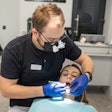
Oropharyngeal (OP) cancers associated with the human papillomavirus (HPV) are increasing, especially among younger patients, but these patients have a better prognosis than those with HPV-negative cancers, according to research presented at the International Association for Dental Research (IADR) meeting last week in San Diego.
The study is significant because it is the first population-based estimates of HPV in OP cancer in the U.S. and includes seven cancer registries (LA, MI, KY, HI, FL, IA, and Los Angeles, CA), according to lead author Jennifer Cleveland, DDS, MPH, a dental officer/epidemiologist in the oral health division at the U.S. Centers for Disease Control and Prevention.
Most other studies have been based on small hospitals or towns, she told DrBicuspid.com.
The study included 573 OP patients diagnosed between 1994 and 2005. It included two groups who were HPV-positive for HPV types 16/18 or other HPV types; a third group was HPV-negative. Most of the OP patients (406) were HPV-positive (71%), and the majority (349) had HPV types 16/18 (86%).
The researchers found that HPV-positive OP cancers are diagnosed later but have better prognoses than HPV-negative cancers. HPV may play a role in the disparities in the incidence and survival among patients with OP cancers, the study findings showed.
The researchers found that HPV-positive cases were highest in the tonsils (72%), highest among males (64%), and highest in individuals under the age of 45 (67%). In addition, most of the cancers (67%) were at regional or distant stages when they were diagnosed. HPV-negative cases were highest in patients older than age 65.
A surprising finding was that a significant number of black OP patients were HPV-negative (53%), Dr. Cleveland said, noting that those patients also have poorer prognoses.
The high OP cancer rate among HPV-negative black patients could be due to a higher rate of smoking and alcohol use, Dr. Cleveland told DrBicuspid.com. It also could be due to physiological factors, she said.
These findings tie in neatly with a paper published this month on racial trends in OP cancers (Cancer Causes and Control, March 6, 2011). In that study, the investigators show, for example, that rates of HPV-related oral-cavity and pharyngeal cancer have tripled since the mid-1940s among white men aged 25-44, to 1.3 cases per 100,000 man-years, surpassing the rate among their black male contemporaries.
"The rates are still very low, but dentists should be aware that this is going on with their young white male patients, and also among their young white female patients to some extent. Things are changing, so be aware," said lead investigator Linda Morris Brown, DrPH, senior research epidemiologist, RTI International.
An academician added that the trends may signal the need not only for oral-cancer screening for all younger, white patients, but also the potential usefulness of broad-based HPV vaccination.
"Although oral and pharyngeal cancer is relatively rare, it may be good public policy to vaccinate both boys and girls against HPV infection," said Kurt Summersgill, DDS, PhD, associate professor in the department of diagnostic sciences at the University of Pittsburgh.
Many dentists confuse oral cancer and OP cancer, which specifically refers to cancers in the oropharynx area, including the posterior pharyngeal wall and the palatine and lingual tonsil, Dr. Cleveland noted.
OP cancer also resembles cervical cancers in that both involve lymph tissue, she said.
"It's interesting that it's about lymphoepithelial tissue, which is part of the immune system, and is similar to where most cervical cancers are found," Dr. Cleveland said. "It's the same type of tissue."
Waldeyer's ring (a ring of lymphatic tissue in the back of the throat) is similar in tissue composition to the cervix, she added.



















